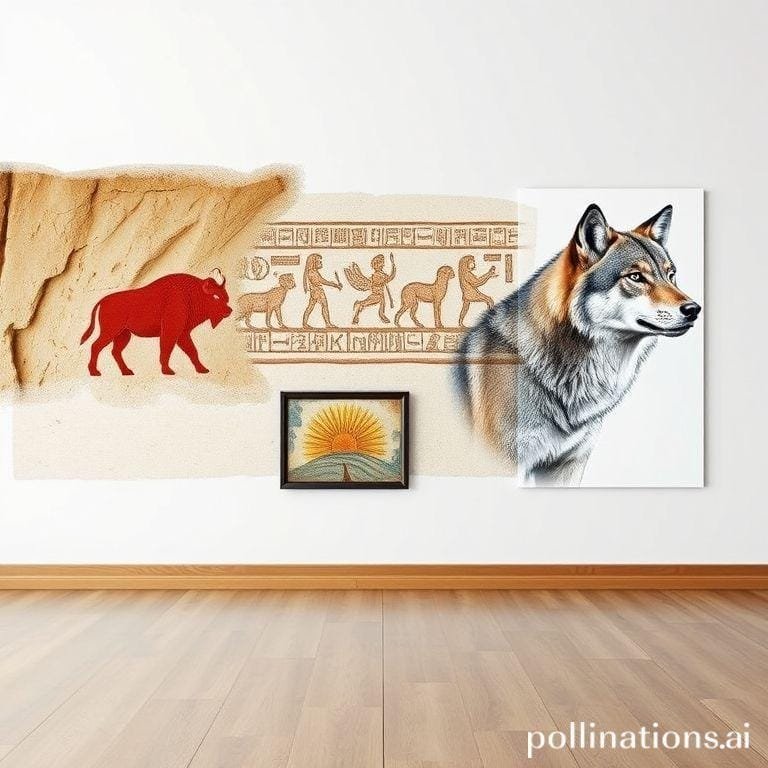Your cart is currently empty!
The Evolution of Wall Art Through Time

Think of wall art like a family photo album that stretches back thousands of years. From the simple drawings in ancient caves to the bright digital pictures in today’s homes, wall art shows us how humans have always wanted to express themselves. It’s like a timeline that tells the story of our creativity, our technology, and how we make our living spaces feel like home.
The First Drawings: Cave Paintings
About 40,000 years ago, early humans used things like charcoal and colored dirt to paint animals, handprints, and symbols on cave walls. Famous caves in France and Spain show us these early artists understood how to make things look real and moving. These weren’t just decorations—they were like early history books or maybe even prayers, helping people understand their world. The materials were simple, but the ideas were huge, planting the seeds for all art that would follow.
Ancient Masterpieces: Egyptian Tombs and Palace Walls
When civilizations began, wall art became more organized, like a school project with rules. Egyptians covered tomb walls with pictures and writing they believed would protect the dead in the afterlife. In other ancient lands, kings used wall art like social media posts to show off their power with pictures of battles and mythical creatures. The Greeks and Romans became experts at painting directly on wet plaster, creating scenes from stories that made their buildings come alive. As one Roman writer noted:
“The walls…should be decorated in accordance with the dignity of the place.”
Religious Stories: Churches and Great Artists
When major religions grew, wall art became like picture books for people who couldn’t read. Byzantine churches used tiny glass pieces to create sparkling holy scenes. In Europe, church walls showed Bible stories through paintings and colored glass windows. Then came artists like Michelangelo, who used walls as giant canvases to explore human feelings and realistic perspectives. The Sistine Chapel ceiling is like the ultimate school project—huge, detailed, and full of meaning.
Home Decor: Tapestries and Wallpaper
During medieval times, wealthy families began using movable wall decorations. Tapestries—those woven picture blankets—served two purposes: they kept rooms warmer and showed off family wealth. Later, wallpaper became popular because it was cheaper and could bring color and patterns into regular homes. This was when wall art started becoming part of interior design, like choosing the perfect outfit for your home.
Modern Changes: New Styles and Ideas
The last two centuries brought big changes to wall art. When photography was invented, it changed how people recorded reality. New art styles broke old rules, moving from painting what things look like to painting how they feel. Canvases became easy to buy and move, making art something people could collect. As Pablo Picasso said:
“Art is a lie that makes us realize truth.”
Posters and prints made famous art available to everyone, turning walls into personal bulletin boards for showing identity and beliefs.
Today’s Digital World: Custom Art
Now we’re in the digital age, where technology gives us amazing new options. High-quality printing lets us create durable, vivid wall art from digital files. Online stores allow endless customization—you can put your own photos, digital designs, or art from anywhere in the world on your walls. At Paw Creativ, we join this modern movement by offering beautiful animal-themed wall art. From wild animal portraits to cute pet pictures, our art uses the best printing methods and materials to help your walls tell your unique story. Visit our gallery at pawcreativ.com to see how you can bring animal beauty into your home.
Looking Ahead: The Future of Wall Art
Wall art continues to evolve. Soon, we might have walls that change with augmented reality—like putting digital art over your real walls. Programmable displays could let art shift with your mood or the time of day. Designers are also bringing more nature themes into homes to help people feel calm and connected. The line between art and our environment is getting blurry, meaning our walls might soon become active parts of our daily lives rather than just backgrounds.
The story of wall art is like watching humanity grow up. It started as community rituals in caves and became personal statements in digital formats. Each era added new techniques and meanings, but the heart remains the same: to make things beautiful, to share messages, and to create connections. As we keep inventing new ways to decorate, our walls will continue reflecting our best creative ideas. Whether you love classic prints or modern digital art, your walls are ready for their next story.
